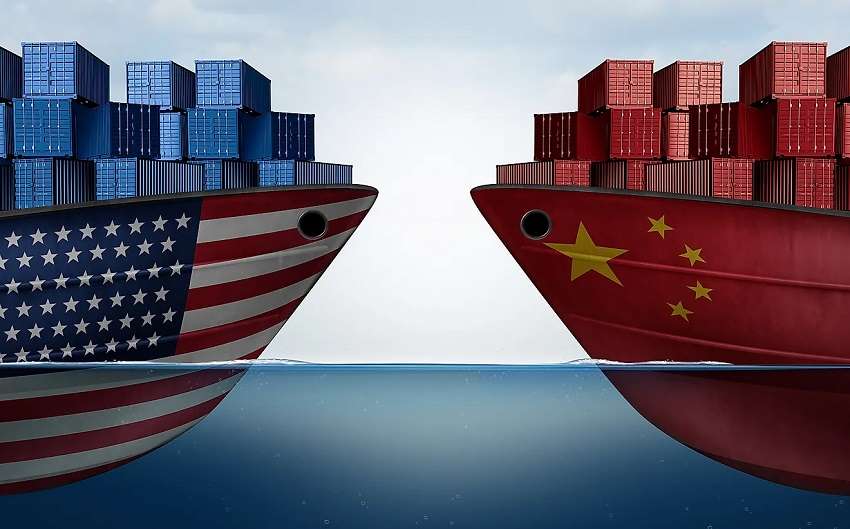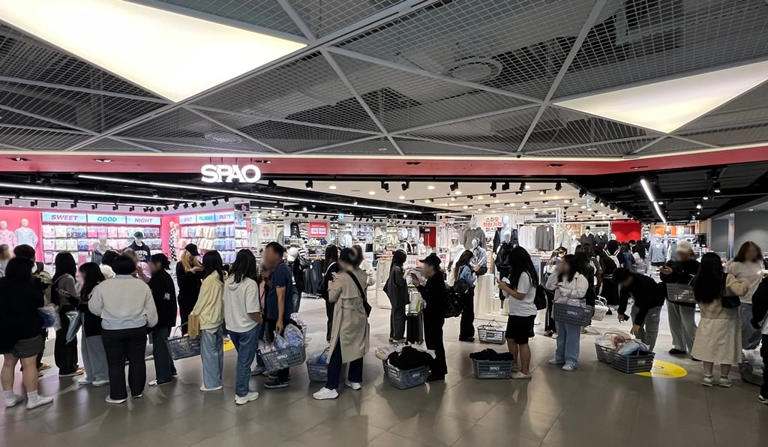FW
Underscoring its local connections as a part of broader efforts to improve the shopping experience both in stores and online, Spanish fashion brand Zara launched its latest collaboration with Chinese textile artist Lin Fanglu on April 24, 2025.
Marking her first venture into wearable design, Lin's collection features apparels for women, men and children along with a home furnishings range.
Eugenio Bregolat Lukashov, President, Inditex-Greater China, emphasized the significance of partnering with local artists, now for the fifth time, noting, such collaborations deepen their connection with Chinese consumers while improving their understanding of the market.
Through this collection, Zara joins a growing trend of fashion and luxury brands actively collaborating with Chinese designers and artists to explore innovative content and formats that go beyond simple cultural representation.
The brand continues to invest in various initiatives aimed at enhancing both in-store and online retail experiences. Recently, it opened its Asian flagship store in the Xinjiekou area, a thriving business hub in Nanjing, Jiangsu province. Designed in collaboration with a local architectural studio, the store introduces innovative features including a salon, fit check, vending machine, and cafe, according to Lukashov.
Thermoplastics are taking centre stage in fibre reinforced composite innovations, as noted in the latest JEC Composites Innovation Awards 2025 report by Textiles Intelligence. While carbon and glass technical fabrics remain the backbone of the industry, thermoplastics are emerging as a sustainable and versatile alternative to thermosets.
Unlike thermosets, thermoplastics can be reheated and reshaped, offering recyclability and reduced waste key factors driving their appeal. Their malleability also supports complex designs and advanced manufacturing techniques like welding and overmoulding.
Several 2025 JEC award winners highlighted these advantages. Airbus (Germany) showcased a full-scale demonstrator of a single-aisle aircraft fuselage made from carbon fibre reinforced thermoplastics (CFRTPs). The CFRTPs can be moulded at high temperatures, allowing for lighter fuselage structures without heavy fasteners.
The CIMNE-led FIBRE4YARDS project received recognition for promoting thermoplastics in shipbuilding. Traditionally used in vessels under 25 metres, thermoplastics are now being applied to boats up to 50 metres. The project tackled high production costs by replacing manual methods with automated systems.
IRT Jules Verne won for the Zebra project, which developed full-scale wind turbine blades using Elium liquid thermoplastic resin from Arkema. Designed with recyclability in mind, the project marks a significant shift toward circular solutions in wind energy.
Despite these advancements, thermosets continue to dominate, especially in aerospace, due to established trust and long qualification cycles. Still, thermoplastics are positioning themselves as the future of composites through sustainability and innovation.
Fitness apparel giant Gymshark’s revenues increased to $760.5 million in FY24 as against $696,5 million in FY23.
The Solihull-headquartered company’s adjusted EBITDA rose to $64.7 million despite rising costs as against $56.7 million in FY23. However, pre-tax profits decreased from $16.4 million to 14.9 million
Led by Ben Francis, CEO, the group traded successfully during FY24 as it revenues grew, profitability improved and it continued to satisfy customers".
During the year, the company focused on reinvesting its profits back into the business instead of declaring a divided. It continued to face challenges due to the general macroeconomic environment which in general affected all apparel businesses and consumers alike.
According to the company’s Board, the group’s inputs costs, including raw materials and labor costs continue to rise, although other costs, notably freight, have significantly normalised when compared with the prior two financial years.
The Board monitors these costs along with the changes in the macro environment, from a general perspective and with regard to conditions in key geographies.
Following a successful debut, Shift is set to host its second menswear-focused edition on June 29 and 30, 2025, at the iconic Muza building in the Taets Art and Event Park, Zaandam, Netherlands. Housed in a former bullet factory, the venue offers a distinctive industrial backdrop ideal for an event dedicated to connection, innovation, and menswear trends.
With its growing reputation in Northern Europe, particularly across the Benelux and Germany, Shift continues to attract attention. Over 80 per cent of last year’s participating brands are returning, joined by new and established names spanning classic menswear, streetwear, denim, sportswear, and avant-garde fashion.
The event follows a ‘plug & play’ model, providing brands with pre-arranged facilities, eliminating costly booth setups. This approach fosters open dialogue and collaboration, staying true to Shift’s mission of accessibility and creative exchange.
Responding to feedback from brands and retailers, Shift is introducing new features, including dedicated order areas and temporary showrooms. These additions are designed to streamline the buying process, enabling brands to schedule appointments and write orders during the event.
Beyond fashion, Shift is expanding its scope to include partners from branding, digital marketing, and in-store retail solutions, offering attendees insights into customer engagement and business development.
The raw, open spaces of Muza lend themselves to creative expression, making it an ideal venue for brands to showcase identity and for retailers to discover new ideas and partnerships. Shift positions itself not just as a trade fair, but as a catalyst for change in the menswear retail landscape.
D’Decor's luxury home furnishings label Sansaar has launched its first ever bedding range alongwith expanded curtain and upholstery offerings in partnership with Bollywood celebrity Ranveer Singh.
Launched at an event at Mumbai's Jio World Convention Centre, the showcase spanning 16,000 sq ft, was attended by over 800 partners and industry stakeholders.
Focusing on spatial storytelling, the event featured a swatch display wall, oversized chair installations, and a full-scale 3D mock-up of Sansaar’s franchisee store and shop in shop formats. It also included a virtual reality walkthrough that enabled attendees to visualise layout options in real time.
The exhibition featured 1,500 new Sansaar products spanning upholstery, curtains, and D’Decor Exports’ premium rugs and blinds. Reinforcing Sansaar’s strategy to offer holistic and sustainable home solutions, the new bedding range is customised to evolving consumer preferences.
Currently boasting over 450 retail touchpoints, and achieving 35 per cent revenue growth in its first year, Sansaar plans to expand its network of standalone stores besides also entering into new strategic partnerships. The business aims to generate revenues worth Rs 500 crore in the next three years.
French actor Adèle Exarchopoulos has been named as the new brand ambassador for the iconic sportswear and lifestyle brand, Lacoste.
At Lacoste's recent runway show in March, held on the center court at Roland Garros in Paris, Exarchopoulos made a notable appearance. She sported a complete Lacoste ensemble for the event featuring a black leather jacket, a matching balaclava, and wide-leg trousers, complemented by a white Lacoste handbag.
The campaign showcases Exarchopoulos as Lacoste's new ambassador with the Lenglen leather handbag, a clear nod to the runway show. However, the overall styling of the campaign is quite different. In one image, Exarchopoulos is seen lying on an apple green floor against a backdrop of the same vibrant hue, her face directed towards the camera. She wears a green open-back top, with the handbag positioned like a skirt and the Storm 96 2K sneakers on her feet, creating a tennis-inspired look.
Besides being the winner of the Best Supporting Actress award at the 2024 César film awards for her role in ‘All Your Faces,’ Exarchopoulos is also an ambassador for Yves Saint Laurent Beauty. She now becomes the new French face of Lacoste, serving as the female counterpart to actor Pierre Niney, who has been a Lacoste brand ambassador since 2024.
Having reported revenues just under €3 billion in 2024, Lacoste aims to reach €4 billion by 2028-2030, according to Thierry Guibert, CEO. The brand aims to expands its business in North America besides increasing sales of its women's products.
Rising pressure from the cotton industry may compel the Indian government to eliminate the 10 per cent import duty and an additional 10 per cent levy on cotton. Removing these duties is crucial for boosting textile exports, the industry argues, citing a current shortage of domestic cotton. However, this potential policy shift could have negative consequences for Indian cotton farmers, it adds.
If import duties are scrapped, the influx of cheaper imported cotton could force domestic growers to lower their prices. This price reduction would not only impact farmers' incomes but also affect the Cotton Corporation of India (CCI), the government agency responsible for purchasing cotton at the Minimum Support Price (MSP). The CCI currently holds about three-quarters of the 10 million bales it acquired this season.
Sources suggest, the Ministry of Textiles supports the removal of the import duty, and the CCI is also likely to concur. The yarn and fabric industries have been actively lobbying for this change, as they currently face an effective import duty of 11 per cent due to a 10 per cent basic customs duty and a 10 per cent levy.
Lalit Kumar Gupta, Chairman and Managing Director, CCI, points out, India annually imports 1 to 1.5 million bales of specific high-quality cotton not produced domestically, which is already exempt from customs duties. He stated, CCI would support the government's decision. While acknowledging potential losses from falling prices, he noted, CCI sells cotton throughout the year, sometimes securing better prices later. The government compensates the CCI for any losses incurred.
CCI is currently selling cotton at Rs 55,000–Rs 56,000 per candy (approximately 785 pounds). In the 2024–25 season, the CCI procured 10 million bales (about 375 pounds each), with roughly 25 per cent sold.
With the MSP-based cotton procurement season concluded, about two-thirds of the crop remains with farmers or has been sold to traders. Industry estimates suggest farmers hold 6–6.5 million bales. Removing the duty could allow imported cotton to land at Rs 48,000–Rs 50,000 per candy, undercutting domestic prices and potentially causing over Rs 20 billion in losses on unsold stock.
The Cotton Association of India (CAI) revised its 2024–25 cotton production estimate downward to 29.53 million bales in March 2025, projecting consumption at 31.3 million bales. The government's second advance estimate aligns closely, placing production at 29.42 million bales.
India's cotton production costs are about 1.5 times higher than in Brazil or Australia, enabling these countries to export cotton to India at lower prices. The yarn and fabric industry argues that expensive domestic cotton hinders the competitiveness of Indian textile exports. However, their existing option to import duty-free cotton under the advance licensing scheme weakens this argument.
Eliminating import duties now could discourage farmers at the start of the planting season, undermining the Cotton Mission aimed at boosting domestic production. Cheaper imports could harm farmers and derail government objectives, potentially leading to political protests in the approximately 220 Lok Sabha constituencies where cotton is grown.
Although Adidas reaffirmed its financial outlook for 2025, the German sportswear company said, it anticipates production costs of all its products sold in the American markets to rise on account of the planned higher tariffs on imports into the United States.
Bjorn Gulden, CEO, says, although the brand has reduced its imports from China to a minimum, it remains exposed to the current high tariffs to a certain extent..
Unexpectedly high US import taxes on Southeast Asian nations like Vietnam and Indonesia, which are currently paused until July, have caught sportswear manufacturers off guard. These companies had depended on supplies from those countries to lessen the impact of US tariffs on goods from China.
Having released stronger-than-anticipated quarterly sales and profit figures in an unscheduled announcement last week, Adidas said, the increased costs would eventually lead to price increases. However, the company added, it is currently impossible to quantify these increases or to assess their impact on consumer demand for its products.
Gulden noted, Adidas would have raised its forecast for the full year, both for revenue and operating profit, following a solid quarter and a strong order book, if it weren't for the uncertainty surrounding the tariffs.
Adidas posted a strong performance in the first quarter of 2025, with revenues growing 13 per cent year-on-year to €6,153 million and operating profit soaring 82 per cent to €610 million. The company’s operating margin rose to 9.9 per cent, driven by strong brand momentum across all categories and regions, even without any contribution from Yeezy products.
The German sportswear giant saw currency-neutral revenues for the adidas brand increase 17 per cent, led by a 17 per cent rise in footwear, 8 per cent in apparel, and 10 per cent in accessories. Footwear growth was supported by robust demand for Originals, Sportswear, Running, Training, and Performance Basketball. The reintroduction of classic models like the Superstar and successful collaborations with celebrities and artists also helped drive sales.
Performance categories such as Running and Training recorded strong gains, with launches like the Adios Pro 4 and Evo SL enhancing adidas position in the performance segment. Meanwhile, Football, Outdoor, and Motorsport collections contributed to further category expansion.
Revenue grew at double-digit rates in all markets except North America, where growth was 3 per cent due to the phase-out of Yeezy. Excluding Yeezy sales, North America also posted double-digit growth. Latin America led regional performance with a 26 per cent revenue increase, followed by Emerging Markets at 23 per cent, and Europe, China, and Japan/South Korea each at 13 per cent or higher.
Gross margin improved by 0.9 percentage points to 52.1 per cent, driven by lower costs and reduced discounting. Marketing and point-of-sale expenses rose 14 per cent to €746 million, reflecting continued brand-building campaigns and major event sponsorships. Net income from continuing operations more than doubled to €436 million.
Despite the strong quarter, adidas is maintaining its full-year guidance due to uncertainty over potential new US tariffs. While the company has minimized exports from China to the US, it remains exposed to broader increases in US import duties. CEO Bjørn Gulden stated the company remains flexible and will focus on delivering strong performance in other regions to offset US market volatility.
For 2025, adidas expects high single-digit growth in currency-neutral sales and operating profit between €1.7 billion and €1.8 billion, excluding any contribution from Yeezy products. Inventories and working capital levels remain healthy to support ongoing growth.

At a time where individuality and self-expression reign supreme, the denim and jeanswear industry is witnessing an unprecedented shift toward customization, do-it-yourself (DIY) fashion, and on-demand production. Consumers are no longer satisfied with off-the-rack designs; they want to infuse their personality into their wardrobes, and denim—known for its versatility and timeless appeal—has become the ultimate canvas for creativity, tailored to their exact specifications.
The rise of customization, DIY, and on-demand in denim
Denim has long been a staple in wardrobes worldwide, but the demand for personalized, bespoke, and instantly produced jeanswear has skyrocketed in recent years. From embroidered patches to hand-painted designs, distressed treatments, and custom fits, denim enthusiasts are embracing DIY techniques and on-demand services to create one-of-a-kind pieces. This trend got a boost from social media platforms like Instagram, Pinterest, and TikTok, where influencers and designers showcase their customized creations, inspiring millions to experiment with their jeans. Moreover, online tutorials on platforms like YouTube and Instagram provide a vast library of inspiration for everyday consumers. The rise of e-commerce has been pivotal in facilitating this trend, providing accessible platforms for both consumers and independent creators.
The power of on-demand
The “on-demand” aspect is a game-changer. It allows for production only when an order is placed, eliminating excess inventory and significantly reducing waste. This approach aligns perfectly with the growing demand for sustainable fashion. It also allows for extremely high levels of personalization, allowing for custom measurements, and designs.
Brands adapting to customization wave
Recognizing the growing demand for personalization and on-demand production, major denim brands are integrating customization services into their offerings. Levi’s, for instance, has grown its ‘Tailor Shop’ concept globally, allowing customers to personalize their jeans with patches, monograms, and unique embroidery. They are also moving towards more on-demand models. This initiative not only increases customer engagement but also promotes sustainability, as consumers are encouraged to repair and upcycle their denim instead of discarding it. Levi's is also exploring and implementing on-demand production to reduce waste and cater to specific customer needs quickly. Similarly, Diesel and Wrangler have introduced customization studios where consumers can distress, paint, and add embellishments to their denim, ensuring a truly unique product.
Smaller, independent denim brands are also capitalizing on this trend. Companies like Unspun, which uses 3D technology to create custom-fit, on-demand jeans, and Blank NYC, which offers hand-painted denim jackets, are revolutionizing the industry by prioritizing individuality and immediate production over mass production. Unspun, the San Francisco-based startup, has taken denim customization to the next level by leveraging AI and 3D scanning technology to create jeans that are made-to-order for each customer. This process eliminates excess inventory, reducing waste while ensuring a perfect fit. The brand’s commitment to sustainability, personalization, and on-demand production has attracted eco-conscious consumers looking for both style and ethical fashion choices.
The DIY culture and e-commerce in denim’s evolution
Beyond brand-driven customization, DIY denim culture is thriving among fashion enthusiasts who prefer to take matters into their own hands. Thrift flipping—where vintage denim is upcycled into trendy new designs—has gained immense popularity, particularly among Gen Z consumers who value sustainability and individuality. Online marketplaces like Depop and Etsy have become hubs for one-of-a-kind, hand-altered denim pieces, boosting the trend. E-commerce platforms have democratized access to materials and tools, making DIY customization more accessible than ever.
Workshops and community events are also playing a crucial role in fostering DIY denim culture. Local designers and artists host denim customization workshops, teaching participants techniques such as bleaching, hand-painting, and distressing. These events not only encourage creativity but also promote sustainable fashion practices by extending the lifecycle of denim garments.
Sustainability and the future of customization
Customization and on-demand production are not just about aesthetics—they are also reshaping the denim industry’s approach to sustainability. Mass production contributes significantly to environmental degradation, with denim manufacturing being one of the most resource-intensive processes in the fashion industry. By enabling consumers to create personalized pieces and producing only what is needed, brands are fostering a culture of conscious consumption, where individuals are more likely to cherish and retain their customized jeans for years.
Moreover, the growing popularity of upcycling and repair services aligns with the global push for sustainability. Companies like Nudie Jeans have pioneered free repair programs, encouraging customers to extend the lifespan of their denim rather than discarding it. As more brands adopt similar initiatives, customization and on-demand production will play a pivotal role in reducing fashion waste and promoting a more circular economy.
Thus the shift towards DIY, customization, and on-demand production in the denim and jeanswear segment is more than just a passing trend—it is a movement that reflects broader consumer values of self-expression, sustainability, and uniqueness. As technology continues to evolve, and as consumers seek greater control over their fashion choices, the industry will likely see further innovations in customization and on-demand services. Whether through high-tech personalization services, hands-on DIY approaches, or instant production, one thing is clear: the future of denim is personal, sustainable, and produced on demand. E-commerce has been, and will continue to be, a key driver in this evolution.











